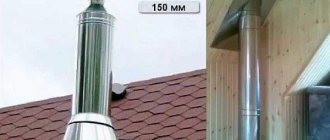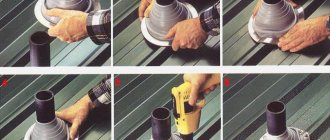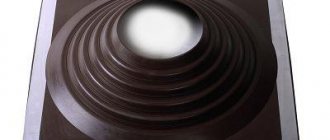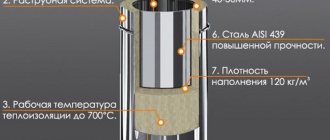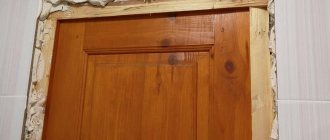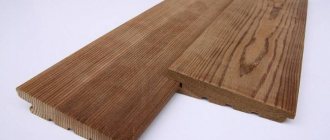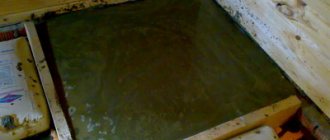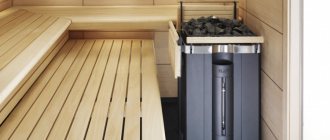The craftsmen who installed chimney systems know what a complex element is the passage of a sandwich pipe through the roof. It is necessary to solve two problems, high tightness along with eliminating the possibility of fire. In the past, professional roofers were hired to solve this problem. Today, the services of professionals are not available to everyone.
Roofing work is one of the most expensive jobs. Areas of the roof with problems were filled with non-combustible material - asbestos. They fastened tin and roofing felt. Sometimes they made cement mortar. Often such actions were not justified. The completed system did not last long. Atmospheric precipitation and severe temperature conditions reduced the service life of the system. It took time to solve this problem.
Experts have found a way out of this situation. An excellent option that makes work easier and extends service life is the Master Flash roofing penetration. Roofing elements help to avoid difficulties when joining elements and save time on the work itself.
Protection from precipitation became perfect when the Master Flash for the pipe appeared. There is an opportunity to do hard, tedious work quickly, efficiently, saving money.
What are the advantages of a master flush?
Experts highlight a number of advantages of such a product.
They are as follows:
- Tight sealing between the chimney walls and the roof. This result can be achieved due to the elasticity of the product;
- Copes with temperature changes;
- Resists corrosion. Most often, such products are made of rubber or polyethylene alloys;
- Has high sealing properties. This was achieved due to the low porosity of the material;
- Quickly returns to its shape when expanded under high temperature conditions;
- Possesses fire resistance;
- Has a long service life;
- Installation can be carried out without a special set of tools;
The installation can be done independently in any weather.
During the installation process, the master flush chimney does not require the use of additional waterproofing. The plastic structure is in close contact with the surface of the roof and the walls of the pipe.
Terms of Use
The elastic Master Flash system is suitable for waterproofing work in areas where the chimney exits through the roof.
Experts advise using such a sealing system for the following heating systems:
- Sandwich chimneys. Such chimneys are pipes made of galvanized metal with a thermal insulation layer of basalt material. Thus, the rubber seal allows you to maintain the optimal temperature inside in such a chimney and does not let heat out of the house;
- Chimneys made of stainless material. Such smoke exhaust systems can heat up to high temperatures, so it is effective to use a silicone sealant for them. Silicone does not deform at high temperatures. Rubber models can only be used with a condenser-type gas boiler.
When sealing uninsulated pipes with the Master Flash system, it is considered advisable to use a special sleeve. To do this, a 500 mm strip is cut from the tube. The chimney outlet is tightly wrapped with fire-resistant material and a sleeve is put on it, which is fixed with a steel clamp.
Distinctive features
Modern models of roof seals have helped replace pipe flashings. Their design is similar to previous products.
Improved linings have the following characteristics:
- Rubber and silicone are used for production. The product is a tapering cone that looks like a flexible cuff. It is this that helps create a tight seal at the junction of the pipe and the roof. In addition, master flash allows you to protect the roof structure from excess moisture and dirt. The upper part of the product accurately repeats the shape of the pipe. At the bottom it connects to the sealing sleeve;
- The base is presented in the form of a flange. It can be made from different materials. The product has a rubberized base, which contains massive ribs. They are equipped with aluminum strips. Thanks to this, the flange is able to take the desired profile shape.
In turn, the seal collar intended for a flat roof can be positioned at a certain angle. In this case, the element is made in the form of a cone-shaped nozzle with corrugations.
They allow you to create the contour of an oval hole with the necessary gradation according to the diameter of the pipe. As a result, they can be used at different angles and independently change it at the desired interval.
Provence
The name of this destination comes from a region in the south of France. Even a small kitchen-living room, the decor of which was inspired by French aesthetics, will be filled with warmth and comfort.
The main thing is that it has a lot of daylight, textiles with romantic prints, and floral patterns. The dining room in the Provence style is designed in pastel shades. Furniture items can be vintage or artificially aged. Plain walls will contrast with large checkered curtains.
The door in the kitchen area set is sometimes replaced with curtains made from the same material as the tablecloth. A good addition would be vases and figurines, clay pots, forged metal parts and ribbons.
Installing master flash
Flexible seal models have made it possible to outperform outdated products in many respects. They can withstand changes in temperature range, do not require frequent repairs and have a long shelf life. As for installation, to carry it out I will need some skills and special knowledge.
How to install Master-Flash for a chimney with your own hands?
- In the upper part, the seal is cut so that a small hole appears.
- After this, the rubber cone is carefully placed on the chimney pipe.
- Next, move it to the very bottom so that it fits tightly to the roof surface.
- You can speed up the process by wetting its boundaries with warm water or soapy water.
Before installation, you need to familiarize yourself with the material of which the roof is made.
After this, we select the mounting method for the flange:
- If the roof is made in the form of a flat surface, then for the work we will use silicone glue or a small amount of bitumen mastic. A similar method can be used for roll coatings;
- A gable or hip roof requires the use of self-tapping screws.
The final step will be to lubricate the cut of the corrugation and cone with liquid nails or sealant. These compounds will create a good seal and increase the service life of the entire structure.
Professional roofers prefer to use a special clamp that is attached to the top edge. During thermal expansion, the rubber nozzle will not lose its properties.
How to install roof sealant?
The general principles of organizing roof passages using Master Flash were given above. In addition, manufacturers provide a detailed description of the installation process. However, there are differences in the installation and fixation algorithms of different models, which are best familiarized with before purchasing.
Installing a seal with a flexible flange
The sealing system with an elastic base is mainly used in the installation of chimneys crossing metal roofs.
Work algorithm:
- We determine the location of the groove on the cone for the upcoming cut. Do not forget that the Ø of the removed segment should be 20% less than the Ø of the pipe.
- Carefully cut off the excess with cable cutter's scissors, trying to make the cut as even as possible.
- We moisten the surface of the pipe to optimize sliding. We put the cuff on the chimney and pull it to the place of fixation, holding the cone and not the flange.
- Having reached the seal to its place, we draw a line around the edge of the flange.
- Slightly lift the cuff to apply adhesive around the perimeter of the flange according to the markings.
- We install the seal in place.
- Apply elastic sealant around the top cut and edge of the base.
The adhesive must match the type of coating. Rules and restrictions on selection are indicated in the instructions attached to the product. For example, gluing master flash with bitumen mastic to a roof with a polycarbonate coating or polymer membrane is prohibited, because the materials will begin to deteriorate and the connection will become unusable.
Master Flash Mount with Rigid Edge
The procedure for installing a seal with an aluminum strip along the edge follows a similar pattern. Before the fastening stage, all work is carried out in the same order. The difference is that during fitting, before outlining the outline of the flange, it must be profiled to ensure a tight fit to the surface of the coating.
Fastening is done with self-tapping screws with a hex head. The fasteners are screwed into the low profile flanges. If desired, for reliable fixation with self-tapping screws, you can buy a counter metal part installed on the back side of the roof.
For roof passages under large chimneys and on roofs steeper than 45º, it is recommended to place the square flange in the form of a diamond. In order to more effectively protect against leaks on roofs with a pronounced ribbed surface and steep slopes, it is recommended to purchase seals with an enlarged base.
The line of cuffs with a metal flange edging includes models with a porous seal located on the back side. To fix them, there is no need to treat the surface with an adhesive. The system is simply screwed to the roof without gluing or filling the seams with silicone. The porous material ensures perfect tightness without additional manipulation.
Insulation for repair operations
Roof seals with a cut are required where it is not possible to put insulation on the chimney from above. Most often they are in demand for repairing worn-out chimney insulation.
Installation algorithm:
- Using cable cutter's scissors, we cut off the top of the cone along the edge, the Ø of which is 20% smaller than the same size of the chimney.
- Remove the toothed fastener from the lock and wrap the cuff around the pipe.
- We connect the sides of the cuff cut and put the fastener back on, without fanaticism squeezing the teeth with pliers.
- Lifting the edge of the flange, we apply silicone sealant to the roof.
- We press the system and apply silicone glue to the fastener and all problem areas of the insulation.
On roofs with an increased likelihood of leaking, systems with an increased base area are installed.
Roll insulation device
For cutting large pipes, rolled material reinforced with aluminum strip is produced. It allows you to seal chimneys of round, square, rectangular configurations. Thanks to its elasticity, pipe bypass parts can be easily formed, and thanks to the built-in aluminum, the sealing system adheres flawlessly to the roofing surface. The method of installing roll insulation is similar to the technologies for installing brick pipes, which we presented in another article.
In order to seal a round chimney, you need to cut a piece of material 30 cm larger than the circumference of the pipe. This must be done so that the insulation is secured with an overlap. Before gluing, the section must be bent like a metal corner so that the vertical shelf is 17cm wide. This part will be glued to the vertical surface of the chimney. Before fixing, the horizontal shelf should be given the shape of a skirt by stretching. The edge of the roll seal can stretch up to 25%. After complete molding and a couple of fittings, the flexible roofing flashing is glued to the pipe and covering.
Square chimneys are covered in four steps in the following sequence:
- Cut out 4 parts of the apron, leaving 30cm allowances at the corners. We stretch the material before gluing, because after that its shape and dimensions cannot be changed.
- We fill the recesses of slate or coverings with a similar profile with silicone or sealant so that the cutting fits tightly. The sealing composition should be no more than 1 cm. There is no need to fill in the corners.
- Glue the top part of the insulation to the walls of the chimney without touching the corners. First we glue the bottom strip of the apron, then we put it on it and glue the two side parts. Then we apply the top strip so that its edges overlap the tops of the sides. As a result, atmospheric water will drain without getting into the butt seams.
- Flatten the apron and glue its lower part to the roof with silicone, not forgetting to glue the corners. We lay a metal strip around the perimeter and secure it with screws or rivets.
Roll insulation can be painted in any color that matches the roof.
Installation of cuffs on tiles and slates
For arranging penetrations through roofs, covering with bitumen and ceramic tiles, slate tiles and slate, sealing systems with a lead or aluminum base are produced. The cone is traditionally cut to fit the collar tightly around the chimney. The upper part of the metal flange must be placed under the covering; on the sides and bottom it is laid on top of the roof.
The upper edge of the base is bent to prevent atmospheric moisture from penetrating into the system. After installation, all problematic connections are filled with silicone compound.
Tips for choosing a product
How to choose the right roof sealant? To do this, we recommend following simple recommendations:
- You can choose flexible types of seals, the base of which is made in the form of a circle or square, for roofs with an acute angle of inclination. Most often it reaches up to 50 degrees. As for the roofing material, the entire roof must be made of bitumen shingles, special steel or profiled metal. Silicone is used for installation;
- It is recommended to use a seal with a flange for roofing structures whose angle exceeds 60 degrees;
- For flat roofs with a slope angle above 65 degrees, it is recommended to select seals whose soft part will have an increased area;
- For flat roofs, cuffs without a flange are suitable. They will be fixed perpendicular to the roof. Bitumen mastic or liquid silicone glue will allow you to create a seal;
For a roof made of tiles or slate, types of seals that are equipped with a metal base with a large area are suitable.
What to consider during work?
Finishing smoke exhaust ducts involves creating a flashing or apron from rectangular sheets of metal. The width of the products is 40 cm, and the length corresponds to the size of the pipe. The plates need to be bent, focusing on the angle of movement of the smoke. To calculate the length of the finish, it is worth considering:
- chimney size;
- the angle that the slope has;
- type of roofing.
Tiled roofs or structures covered with corrugated sheeting are connected using the standing seam technique. Pitched roof structures require a special “side” made of wooden beams, which prevents exposure to weather factors.
What materials are master flash made from?
The following types of raw materials are used for the production of this product. These include:
- Rubber. Rubber resin must be of high quality. Thanks to this, the finished product is able to cope with high temperatures and various natural disasters. Experts say that master flash made of rubber has a long service life;
- Silicone. This type of material is not afraid of any mechanical stress. It is able to withstand air temperatures over 200 degrees.
Why is it needed?
Master flush is a universal type of sealant for effectively insulating roof penetrations. The device can be used for all types and coverings of roofs. Well suited for roofs made of metal tiles, corrugated sheets and tin. Installation of the penetration can be carried out both on a roof with a metal deck, and on a soft roof, sand-cement or slate.
An important advantage of the device is its resistance to temperature changes and exposure to sunlight. Therefore, installation of the penetration can be carried out at any time of the year and at any temperature.
- Flexibility. With the help of a sealant it is easy to create a tight fit to the chimney;
- Heat and frost resistance;
- Not susceptible to oxidation;
- High strength of the material;
- High level of sealing against water ingress;
- Resistance to deformation;
- Long warranty period up to 30 years;
- Easy to install;
- Savings on additional waterproofing work around the device.
Photo of master flash for chimney
Penetration sealants.
To install this “Master Flash” device, owners of private houses must select a suitable hermetic adhesive. Which sealant is best suited for these purposes will depend on the manufacturer and the quality of the glue. Thermal sealant “Titan” has good reviews; roofing sealant, bitumen sealant “OLIMP” and silicone sealant “STAYER” also have good qualities. Currently, you can study the properties and advantages of sealants for installing Master Flash protection by going to the Internet, where buyers share their experience in installing the device, and also leave various reviews about sealed adhesives.
Equipment
To seal the roof of a chimney on the roof, using the flush master itself is not enough. In addition to it, as already mentioned, the kit includes a special amplifier frame for the base. Also, some manufacturers of chimney passages through the roof equip their product with individual fasteners. As a rule, they are not included in the price.
Master Flash compactor device
Facing with wild stone
This material gives the house an aristocratic appearance and allows its owner to distinguish his home from the gray and monotonous mass of other buildings
When using facing stone, pay special attention to caulking all seams, especially for interior finishing. But, wild stone is often used as a means of cladding on the outside, giving its natural and presentable appearance. In addition, the wear resistance threshold of such elements is also surprising.
In addition, the wear resistance threshold of such elements is also surprising.
Stone-lined chimney on the second floor.
Marble plaster
This is a crumb where particles of small pebbles are mixed into a solution. Cladding, therefore, is only permissible inside buildings, since the crumb does not like exposure to cold temperatures. It goes well with fireplaces and traditional stoves, especially if the kitchen area is additionally finished with such chips, not to mention brick chimneys.
Venetian plaster
On sale it is a white powder, which must be dissolved in water when applied. If desired, you can add different colors, resulting in a rich selection of shades. Keep in mind that decorative cladding must be carried out on a pre-prepared base - plaster. After application (use a spatula), it is recommended to dry with a hairdryer.
Types of roofs and their area of application
There are the following types of roofs:
- ridge;
- single-slope design;
- decyl;
- decylless;
- universal.
Let's look at some of them in more detail.
Skate. It is used during installation work and installations with access to the outside through the roof through the ridge. This insulation option allows installation above the roof with an overhang of only 500-600 mm
It is important that the rules of wind support are not violated.
There's no point in talking about installation. The photograph clearly shows the working parts. It is better to watch the video material presented by specialists on our website about installation possibilities.
Watch the video
Watch the video
